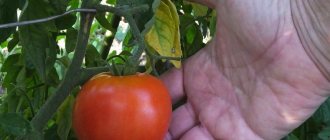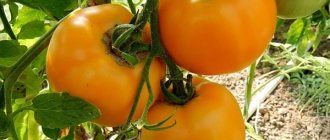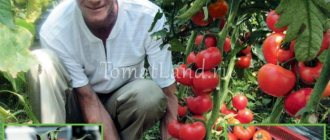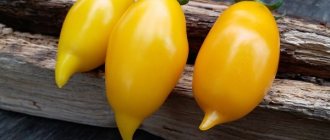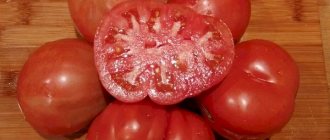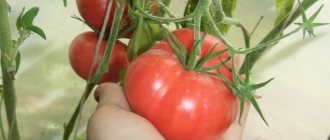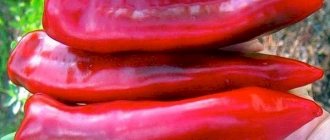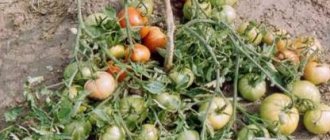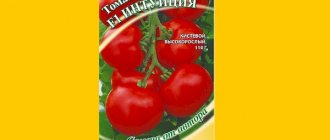Is it true that tomatoes prevent cancer? How to make tomatoes as beneficial as possible for your health? Should I eat them raw or processed? Are all tomato-containing products equally healthy? What is the best way to store tomatoes? An expert from Roskachestvo answers these questions.
Tomatoes are an excellent source of potassium, vitamin A, vitamin C and vitamin K. Tomato must be present in the diet of people with high blood cholesterol levels - the fiber contained in the fruit will reduce it. In addition, tomatoes are especially rich in lycopene, an important phytonutrient with antioxidant properties. Lycopene is indispensable for the digestive system: it stimulates the digestive glands and normalizes appetite. Eating 200 g of red tomatoes will provide the body with the recommended daily dose of lycopene (≥ 5 mg per day), as will half a glass of tomato juice.
According to Consumers Report, citing a 2022 study, men who eat tomatoes every day reduce their risk of prostate cancer by 28%.
Health Benefits of Lycopene
1. Lycopene is a natural food antioxidant. What is he doing?
- Helps reduce oxidative stress levels. Oxidative stress is one of the causes of chronic fatigue, premature aging, and severe chronic diseases: hypertension, Alzheimer's disease, diabetes.
- Helps strengthen bones, protect against atherosclerosis, cardiovascular diseases, and kidney diseases.
- Increasing lycopene in the diet reduces the risk of prostate cancer, as well as the overall risk of developing benign and malignant tumors.
- Lycopene helps maintain firm skin and strong hair.
2. Lycopene is found in tomatoes, and in maximum quantities in tomato paste, since its concentration in the product increases when the liquid evaporates: fresh tomatoes contain up to 70 mg/kg of lycopene, and real tomato paste – up to 1,500 mg/kg. Yes, that’s right: tomato paste is “tomatoier” than fresh tomatoes!
People who closely monitor their health may have noticed lycopene in capsules in pharmacies at prices ranging from several hundred to several thousand rubles per jar. So, tomato paste is not only cheaper, but also healthier than vitamins out of the box.
In many countries, the quality and usefulness of tomato paste is assessed precisely by its lycopene content, and standards regulate the level of lycopene, and not just the composition or the presence/absence of additives. For example, in some African countries, powdered lycopene from selected tomatoes can be added to tomato concentrate from insufficiently red tomatoes so that the product is certified and entitled to be called tomato paste.
In Russia, the content of lycopene in tomato paste, unfortunately, is not regulated by GOST. Therefore, the consumer may not receive the intended benefits from tomato paste, even if he buys an expensive product that meets government standards.
Only in 2016 did Russia begin to produce tomato paste from selected Astrakhan tomatoes with a proven high lycopene content. So far, only one manufacturer makes this; the paste is called “Box of Astrakhan Tomatoes.” And it’s not so easy to find it on sale; it disappears from the shelves all the time: demand is still outpacing production volume.
3. The daily dose of lycopene is contained in a plate of borscht cooked with real tomato paste. Meat stewed in tomato, cabbage rolls, goulash - a huge amount of delicious food can be prepared with natural tomato paste and thereby include lycopene in your regular diet. The price of real tomato paste “Box of Astrakhan Tomatoes” is 740 g – 150 rubles.
Cherry tomato.
Cherry tomato is a type of tomato with small fruits. The cherry tomato has been cultivated since the 1800s. They are believed to have originated either from Aztec Mexico (15th century AD) or from northern Chile or Peru. Cherry tomatoes come in different sizes.
Cherry tomato
The first cherry tomatoes were grown in Europe in the 16th century and were yellow in color. In 1973, Israeli geneticists, after a 12-year program to create tomatoes with improved ripening time and shelf life, created an improved cherry tomato variety.
Cherry tomato is a heat-loving and capricious plant. It does not grow and dies at the following temperatures: above +40 degrees Celsius and below +14 degrees Celsius. There are several varieties of cherry tomatoes. These are what are called "indeterminate" varieties, meaning they will continue to grow taller until they are killed by frost. Cherry tomatoes are as follows: in color - red and yellow with shades, in shape - similar to the shape of grapes, pears, elongated, round. Cherry tomatoes can be grown in greenhouses, summer cottages, and flowerpots.
Cherry tomatoes are small-sized versions of standard beefsteak tomatoes, but they are just as nutritious. In addition to the 1.3 grams of protein, 1.8 grams of fiber and 20 mg of vitamin C in 1 cup of cherry tomatoes, you'll also get a healthy dose of the vitamins and minerals you need for good health.
If you are under 50, you need 1.3 mg of vitamin B6 per day, and after 50, you should get 1.5 to 1.7 mg of essential vitamin B1. A glass of cherry tomatoes provides 0.11 milligrams for these purposes. Vitamin B6 promotes better protein absorption by the body and supports intellectual development and brain function. The nutrient helps in the production of red blood cells and strengthening immune defenses.
1 cup of cherry tomatoes contains 63 mcg of vitamin A. Women need 700 mcg of vitamin A every day and 900 mcg for men. Vitamin A keeps your eyes healthy and in good working order. This vitamin helps the body produce white blood cells and helps the heart, lungs and kidneys function properly.
Cherry tomatoes may provide protection against osteoporosis, brain damage, and skin damage caused by ultraviolet radiation. Cherry tomatoes contain choline, which helps keep the liver healthy. Cherry tomatoes contain lycopene (read about it below).
Cherry tomato
The use of cherry tomatoes in dishes.
Cherry tomatoes taste sweeter than large tomatoes. Small cherry tomatoes always diversify your taste and decorate ready-made dishes. Fresh and raw cherries are pickled, dried and dried.
Cherry tomatoes go well with spinach or green salad. You can chop fresh tomatoes and combine them with minced garlic, onion and lime juice. You can toss halved cherry tomatoes with low-fat cottage cheese for a tasty and nutritious snack. You can fry chopped tomatoes with onions and garlic. This is a delicious seasoning for fried chicken, pork chops or steak. Puree made from tomatoes can be combined with garlic, onions, green peppers and mushrooms. Makes a nutritious pasta sauce.
You can stuff cherry tomatoes with nuts, cheese, anchovies, olives with the addition of sour cream or mayonnaise. A small container of cherry tomatoes can be easily carried with you on trips or for a snack at work.
Using tomatoes for dishes
How to distinguish real tomato paste from diluted concentrate
- Compound. There is NOTHING in real, natural tomato paste other than tomato paste.
- Color. Real tomato paste is bright red because lycopene is that color. A brown tint indicates that the tomatoes were steamed dirty and/or with leaves. Or that the product contains additives, such as starch. Or the production process was disrupted. One way or another, any color other than bright red indicates that the product is not natural enough.
- Compliance with GOST, not TU (technical specifications). Specifications are soft requirements of line ministries, approved with minimal formalities. GOST – higher quality requirements. Thus, GOST for tomato paste requires that the amount of dry substances be at least 25%. Tomato paste “Box of Astrakhan Tomatoes” contains 25-28% dry matter.
- Origin of raw materials. The more a manufacturer knows about raw materials, the better control they can have over the quality of the final product. Therefore, producers who grow tomatoes themselves must indicate exactly where their land is located. If the can does not say where the tomatoes grew, it means that the manufacturer does not know where the raw materials came from, where they were grown, what fertilizers were used during processing, and so on. Perhaps the manufacturer didn’t even buy tomatoes, but Chinese tomato concentrate, and even if he wanted to, he couldn’t vouch for its quality.
- Aroma. Real tomato paste smells like fresh tomatoes, fake tomato paste smells like spices or vinegar, and may not have a distinct smell at all.
Rules for consuming foods rich in lycopene
The optimal daily dosage of lycopene is 5-10 mg. But with an average diet, the substance enters the body in a volume of no more than 0.6-1.6 mg. The process of its absorption directly depends on the presence of fatty foods in the diet. The most suitable way to cook with lycopene is to fry it in vegetable oil. If, due to the introduction of new products, the stool is disrupted, it means that the beneficial element is not completely absorbed by the digestive system.
An allergic reaction to a carotenoid is often accompanied by skin rash and itching. In some cases, watery eyes and runny nose develop. These symptoms indicate the need to review your diet.
Real tomato paste and diluted concentrate - what is on the market
Most tomato paste producers in Russia dilute the concentrate purchased in China with water. It looks like a huge piece of plasticine and comes in bags.
It looks like this:
A company that produces tomato paste from such a Chinese concentrate never knows: – where exactly the tomatoes were grown; – whether harmful chemicals were used in their production; – whether the tomatoes were properly prepared before evaporation, did they bother to wash them at least once; – whether the technology for the production of tomato concentrate is consistent, or whether the tomatoes are evaporated along with branches, stalks, and soil residues; Are there any additives in the product, for example, starch for volume?
Most domestic manufacturers add salt, sugar, flavor enhancers, and starch to tomato paste. Some additives make the original faded taste of the concentrate more digestible, while others increase the volume of the product. But real tomato paste is self-sufficient and does not require any additives - not even water.
And there are only a few domestic producers who do not use Chinese concentrate at all, but produce a natural product. But almost no one grows tomatoes on their own - they mostly buy an already evaporated product and stick on their own label, not knowing how the tomatoes were grown and processed.
As of the end of 2022, the Green Ray company is one of the few (and according to the company, the only!) Russian manufacturer that makes tomato paste entirely from its own raw materials, and has areas for growing vegetables and a tomato processing line. At its Green Ray it produces tomato paste “Box of Astrakhan Tomatoes”.
The name “Box of Astrakhan Tomatoes” is telling. It means that to produce a kilogram of tomato paste, 7 kg of tomatoes are used - a box. And in one 205 ml jar there is almost 1.5 kg of fresh tomatoes.
The plant for the production of tomato paste “Box of Astrakhan Tomatoes” is the most modern in Russia and one of the best in the world. It was built by Rossi & Catelli - CFT SpA - a world leader in the production of vegetable processing lines. In particular, only this plant in Russia has a three-stage washing of tomatoes, which allows you to remove all dirt from the fruit without damaging the delicate skin. But with one- or even two-stage washing, soil, sand, leaves may remain on the tomatoes, and all this will go into processing along with the tomatoes. The result will be an unhealthy brown or red-brown paste with a questionable composition.
Tomato paste is sold in glass and tin jars. Which one should you prefer?
- When purchased in a glass jar, you can evaluate the color and consistency of the product. If the brand is new to you, choose a glass jar to immediately evaluate the simplest sign of a product’s naturalness – color. It is impossible to understand what color the paste is in the tin.
- Paste in a jar with a lid does not dry out in the refrigerator. Glass jars most often have lids that can be opened and closed as much as you like. An open tin can, on the contrary, cannot be closed back. So if you use the paste little by little, then glass is preferable, but if you use the whole jar at once, you can buy both glass and tin.
Useful tips
Like other useful elements, lycopene has a lot of nuances in its use. These must be taken into account in order to avoid unwanted side effects. When eating food containing it, it is recommended to consider the following tips:
- honey enhances the beneficial properties of carotenoid pigment when consumed together;
- after heat treatment, the amount of useful substance does not decrease;
- natural sources of the substance are especially needed after suffering from an illness and during the winter;
- The element needs fatty foods for complete absorption;
- it is permissible to practice fasting days on foods with lycopene;
- biological supplements containing the substance should be taken only after consultation with a doctor;
- if an allergic reaction occurs, you need to take an antihistamine and change your diet;
- biological supplements containing the element should not be taken for longer than 1 month.
Attention! An excess of the substance in the body may be accompanied by an orange coloration of the liver and skin surface.
Production of Green Ray tomato paste
- Green Ray is the largest domestic company for the production of canned vegetables, which grows its own vegetables. Green Ray grows more than 90% of what is packaged in jars (tomatoes, corn, peas, cucumbers, herbs) independently. Since 2022, the Green Ray holding has been operating a huge agro-industrial complex “Astrakhansky”: 20,000 hectares, of which 15,000 are devoted to the cultivation of vegetables and 5,000 to the production of canned food. They don’t use harsh chemicals to increase productivity - there is enough land to let it “rest” for a year or two and accumulate minerals on its own.
- Tomato paste made from Astrakhan tomatoes is “that same pure taste of tomatoes”, familiar from childhood to everyone who lived in the times of the USSR. It is so tasty that you can simply eat it from the jar with a spoon - it tastes like a juicy ripe tomato straight from the bush, without salt or other additives. Astrakhan tomatoes are one of two varieties of tomatoes in the world with a certificate of geographical name (the second such variety is San Marzano from the town of San Marzano sul Sarno in Italy). This means that the taste is unique and different from other tomatoes. Juicy, fleshy, rich in lycopene, Astrakhan tomatoes are first-class raw materials for the production of real, tasty and healthy tomato paste.
- One of the most important factors in making real tomato paste is thoroughly washing the tomatoes. Green Ray at the Astrakhansky agro-industrial complex has a three-stage system for gentle washing of raw materials. Hence the bright red color of the paste: only tomatoes, no soil, dirt, or stems.
- The plant for the production of tomato paste at the Astrakhansky agro-industrial complex is the largest in Russia and one of the best in the world. It was built by Italians from Rossi & Catelli - CFT SpA, a recognized world leader in the production of equipment for vegetable processing and the production of tomato paste.
- The price of Green Ray products is an honest price for natural tomato paste made from real fresh ground tomatoes. By growing vegetables independently in Russia, Green Ray is minimally affected by currency fluctuations.
- Tomato paste “Box of Astrakhan Tomatoes” has been tested by Roscontrol for product quality, compliance with the standards and composition specified on the label https://roscontrol.com/product/pasta-tomatnaya-yashchik-astrahanskih-pomidorov/. Roskontol confirmed that the tomato paste “Box of Astrakhan Tomatoes” is a high-quality product, the composition of which fully corresponds to what is indicated on the packaging: this paste contains ONLY Astrakhan tomatoes and there are no foreign impurities, such as starch.
Video of the production of tomato paste “Box of Astrakhan Tomatoes”:
